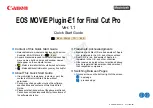
See also:
■
“
” on page 105
VRML Page
Use this page to adjust the options for the VRML file reader.
Default Units
Specifies the type of units Autodesk Navisworks uses when opening VRML world files.
Faceting Factor
Enter the required value to control the level of faceting that takes place.
The faceting factor must be greater or equal to 0, where 0 results in the faceting factor being turned off. The
default value is 1. When you double the value, you get twice the number of facets. When you halve the value
you get half as many facets. Larger faceting factors result in more polygons to a model and larger Autodesk
Navisworks files.
Max Facet Deviation
This setting controls the greatest distance between the edge of a facet and the actual
geometry.
If this distance is greater than the
Max Facet Deviation
value, Autodesk Navisworks adds more facets.
If the
Max Facet Deviation
is set to 0, then this function is ignored.
Override Normals
Normals control how objects appears when lit. By default, this check box is clear, and the
file reader uses the data provided in the VRML file, giving the most accurate visible results.
Select this check box if you want Autodesk Navisworks to ignore the normals, and generate the lighting data
instead, for example when the supplied model contains invalid lighting data.
NOTE
Using this option is less accurate than using real lighting data in VRML files.
Override Orientation
By default, this check box is clear, and the file reader processes the geometry information
in order indicated in VRML files, which can be clockwise or counter-clockwise.
When this check box is selected, the file reader ignores the order in VRML files, and processes the geometry
information counter-clockwise. This option is useful, if your model, when viewed in Autodesk Navisworks, has
holes or black areas in it.
Override Switch Statements
By default, this check box is clear. This means, the file reader uses the default
behavior of the switch statements in VRML files.
For switch statements that are used in VRML scripting, related geometry is only converted if the corresponding
switch is turned on. As a result, you can get a mostly empty model in Autodesk Navisworks.
When this check box is selected, the file reader processes all switch statements, and brings through extra geometry.
NOTE Overriding Switch Statements
can result, for example, in creating duplicate geometry if the switch statement
contains several ways to represent the same object.
See also:
■
“
” on page 105
Z + F Page
Use this page to adjust the options for the Z+F Scan file reader.
Sample Rate
Specifies the frequency of points extracted from the input file.
Increasing the sample rate, reduces the number of points extracted. As a result, the image resolution is reduced,
and the file is converted faster.
Remove Spurious Points
Select this check box to ignore spurious points in the input file.
When this check box is clear, the file reader extracts spurious points.
Point Intensity
Specifies how points are extracted from the input file.
430 | Chapter 17 Autodesk Navisworks Reference
Summary of Contents for 507B1-90A211-1301 - NavisWorks Manage 2010
Page 1: ...Autodesk Navisworks Manage 2010 User Guide March 2009 ...
Page 12: ...xii Contents ...
Page 14: ...2 Part 1 Welcome to Autodesk Navisworks Manage 2010 ...
Page 64: ...52 Chapter 3 Installation ...
Page 97: ...Get a Whole Project View 85 ...
Page 98: ...86 Part 2 Get a Whole Project View ...
Page 136: ...124 Chapter 5 Work with Files ...
Page 178: ...To toggle ViewCube Click View Head Up Display ViewCube 166 Chapter 6 Explore Your Model ...
Page 262: ...250 Chapter 9 Use Viewpoints and Sectioning Modes ...
Page 270: ...258 Chapter 11 Work Within a Team ...
Page 282: ...270 Chapter 12 Share Data ...
Page 346: ...334 Chapter 14 Create Photorealistic Visualizations ...
Page 460: ...448 Chapter 17 Autodesk Navisworks Reference ...
Page 466: ...454 Glossary ...
















































